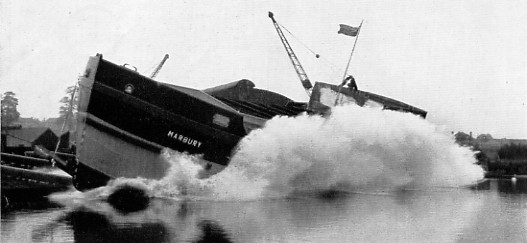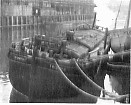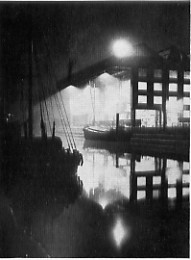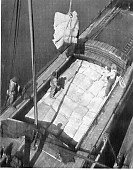| River Craft. In the very early days of Brunner Mond, hired flats brought bone liqor (ammonia), coal and coke to Winnington and took their products back to Liverpool. Some names recorded in early letters are the "Gnat" (the first ever to bring raw materials to Winnington), "Concordia," "Bickenshaw," "Emiline" and "Fred Hickson." Liquor, they say, used to come down from Manchester way, in a double-ended barge owned by a Mr Samuel Buckley, which was chiefly remarkable for the two mules- "Moody" and "Sankey," which pulled it. The first cask of ash ever taken to Liverpool was by the flat "Jane"- under the command of Captain Nathan Hough who later left to join Crosfield's. From the beginning, Brunner Mond decided to build up their own fleet and it is told that Mr Pickering, the first Traffic Manager, withdrew all his savings and lent them to John Brunner free of interest to enable the firm to buy a second-hand boat from Robert Hickson, the Salt Merchant. In his honour, this, the first of that Fleet, was renamed the "Harry." The first barge built for the fleet was the "Crescent" in 1880, and this was followed in 1882 by the tank barges "Courage," "Patience," "Perseverence" and "Success" - 'the names being an apt tribute to the qualities displayed and the result obtained by the Partners who founded our concern. Of these we have no record except of the "Perseverence," which is said still to be at Linacre- the site of an early Brunner, Mond plant for converting "gas water" from nearby Gas Works into Ammonia Liqour such as we use in our process today. For the rest of the fleet, let Capt. Griffiths, our marine superintendent, speak:- "From these small beginnings the fleet has grown to its present size. We now have 28 craft running from Winnington to Manchester, Ellesmere Port, Bromborough, Birkenhead and Liverpool. The ages of the fleet range from the wooden "Triumph" built in 1890, to the modern "Marbury," launched in October, 1948. Despite her age, the 'Triumph' is still seaworthy, and bears the hallmark of the hand of the master craftsman, and is a monument to those old Northwich Shipwrights who built her, and many of her wooden sisters. |
| T |
| River Transport (From a retrospective in 1948) |
 |
| The Launch of the "Marbury." |
| "Similar timber to that used in Drake's Day, was used in her construction, the crooked oaks for knees and breast hooks, the bent oaks for frames, and the straight oaks for planking. The whole, fashioned by hand, still sails between Winnington and the Mersey ports, carrying products to the foreign-going steamers, the large sisters who will carry them to the far ends of the Globe. These modern foreign-going ships, with their smoke stacks, and bluff bows, are far removed from the the tall-masted, clipper-bowed wind ships that were seen in the Mersey Docks when the 'Triumph' was young. There was no Manchester Ship Canal then with its long lighted channel, and navigation was one continual fight with weather and tidal conditions. |
 |
| The "Triumph." |
| "The latest [1948] craft built for Estuarial service is the "Marbury," launched in October. Gone is the wooden hull, with the white wood decks and the open steering position. This 'Marbury' is following the fashion set up by her modern gallivanting, foreign-going sisters ; a steel hull, topped by steel decks, the shell no longer built with steamed planks moulded and shaped by the hands of a shipwright, but plates of steel, heated and hammered by a thousand horse power. A wheelhouse has taken the place of the grating aft where the helmsman stood in all weathers, getting soaked not only from the rain and snow, but also getting soaked from the seas as they swept on deck during rough weather, crossing the Mersey. The wheelhouse is now totally enclosed, having windows on all sides ; these can be opened in hot weather by the same means as are used in railway carriages. The plumbing arrangements are modern, with fittings that would favourably compare with arrangements expected in modern houses. Hot and cold running water is laid on to a washplace and galley, the latter fitted with a range that could cook a five course dinner for the crew of four. |
 |
| Night Loading, Wallerscote. |
| Gone are the boxed-in bunks in the cabin forehead, with their wooden shutters ; the drop-down table, and hinge-topped lockers which were used to sit on, are gone. Open bunks, with curtains, are fitted in accordance with modern marine practice. An upholstered settee in uncut moquette is used to sit on, with chairs upholstered in the same manner for use at the light oak cabin table. Four light oak, full-length wardrobes are also fitted. The whole cabin is finished in white enamel, with light oak woodwork and a pleasing shade of green upholstery. |
 |
| The river craft were an integral part of the organisation- a vital link between the producers and the users. For ICI they carried 'products for the distribution department, raw materials for the production departments, gear for the maintainance department and refuse for any department.' 'A craft can usually be seen in the vicinity of any Engineering job being carried out on the river bank.' "All craft carried on through the war years, facing the blitz at night while lying in the target area, and having the added danger of using the mine-strewn Mersey while on passage to and from the Mersey Docks. |
| Happily, the losses were confined to the "Rose," totally destroyed, with three other river craft damaged. |